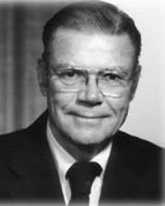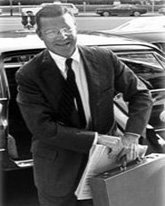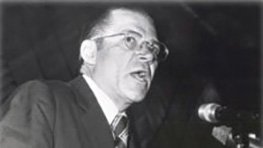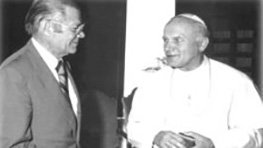5th President of the World Bank Group, April 1, 1968 - June 30, 1981
McNamara eschewed the cautious, Wall Street-oriented approach of his predecessors. He adopted an aggressive mission that emphasized the claims and expectations of the Bank's developing member countries. The needs of the developing world - not the need to satisfy the investment community - became paramount in determining the type and quantity of the Bank's activities.
The Bank that McNamara left in 1981 was completely transformed from the institution he had entered thirteen years earlier. It was a much larger organization, and much more complex. Its membership had continued to expand, and with the People's Republic of China assuming full participation, it was well on its way to becoming a universal organization. The Bank began to address problems of income disparity and poverty. The Bank diversified into sectors of activity where progress was inevitably slow and unspectacular. And the Bank became more deeply involved in the economic and social conditions of its borrowers. It diversified its sources of funding, drawing from a growing number of international sources.
McNamara's role as a spokesman for the developing countries and the size and financial weight of the organization that he led assured the Bank a position of authority as intermediary between the rich and poor countries. The Bank played a critical role in many developing economies, and its coordination of aid with other donors greater increased the leverage it wielded. The strengthening of the research staff stimulated interaction with the academic community and allowed the Bank to claim a role as an intellectual leader in development matters.
Personal History
Robert Strange McNamara was born in Oakland, California in 1916. He attended University of California at Berkeley, majoring in economics and excelling in his studies. His personal experiences during the Great Depression and the liberal outlook at Berkeley combined to shape his liberal social outlook. He enrolled in the Harvard Business School in 1937 and it was here that he acquired the management techniques that became characteristic of his leadership style. The concept of management based on the accumulation and analysis of quantitative data appealed to his disciplined mind and provided him with a tool for exercising control in uncertain conditions.
He applied this management style in the military during World War II and in private industry (Ford Motor Company) after the war. The aggressive new management techniques earned McNamara and his colleagues the nickname "Whiz Kids." In November 1960 McNamara was named president of Ford Motor Company. But after only one month in this position, McNamara was called to the new Kennedy administration to serve as Secretary of Defense, with a mandate to bring the military under control through the application of efficient management.
McNamara quickly became involved in the substance and politics of government administration, and Presidents Kennedy and Johnson sought his advice on defense, foreign policy, and international relations. The Vietnam War claimed much of McNamara's time and energy at the Defense Department, and over the years he began to feel that victory in this war was impossible. His thinking on the war gradually diverged from that of President Johnson, and Johnson abruptly nominated McNamara as the next World Bank president.
Role of the World Bank
The World Bank was, to McNamara, "an innovative, problem-solving mechanism…to help fashion a better life for mankind in the decades ahead." The primary consideration driving the Bank was the needs of the developing countries. It was obvious that these countries required more assistance than they had been receiving, and he set out to make the Bank a "critical mass" of financial and technical power. McNamara realized that the Bank could not solve by itself the world's problems; but it could provide leadership and the will to leverage the world's resources for development.
McNamara believed that there was a direct link between concerns about military security and economic development. For McNamara the threat of warfare was a consequence of the widening income gap between the industrial and developing countries.
Enlarging the Bank
McNamara was never constrained by the Bank's tradition of financial prudence. He felt that the daunting problems faced by the world required daring and risk-taking. Upon his arrival at the Bank, McNamara was surprised at what he considered the small volume of lending the Bank had made compared to the vastness of the needs. He developed an elaborate system of numerical reporting tables that provide complete and up-to-date pictures of the lending program and country needs: the Bank's balance sheet, cash flow, lending program, and borrowing requirements. These reporting methods grew progressively more complex as McNamara insisted that more data be included in the reports.
Bank commitments increased from an annual level of about $1 billion in 1968 to over $13 billion in fiscal 1981. Governments were urged to speed up the preparation of appropriate projects to expedite the increased lending. McNamara quickly realized that a list of individual projects for a particular member country should conform to an overall development strategy, and in 1969 he instituted the practice of creating Country Program Papers.
The proposed increase in the Bank's activities required a rapid expansion in the number of staff. Between 1968 and 1973 the professional staff increased in number by 125%. The staff as a whole grew from 1,600 at the time he took over to 5,700 when he left in 1981. In addition to the increase in numbers, the nationality diversification of staff was increased. The results of these simultaneous changes caused some degree of tension and strain among staff during this period.
McNamara also decided that the Bank's organizational structure required an overhaul. With an expanding volume of business the system of large centralized projects departments and geographical regional departments became unwieldy and bureaucratic. In 1972 he hired McKinsey & Co. to analyze the existing structure and business and to make recommendations for change. McNamara followed the process closely and in 1972 a major reorganizaiton of the Bank took place. Responsibility for lending was placed in the hands of regional vice presidents, who had control over resources required to meet agreed output targets.
McNamara expanded the geographical range of the Bank's lending, and the Bank became actively engaged in all countries that needed help. He re-established lending relationships with Egypt and Indonesia, and the latter became one of the Bank's most important country programs. McNamara took personal charge of the membership negotiations with the People's Republic of China. The prospect of extending the Bank's support to a country with a billion people was a fascinating challenge for McNamara, and he used his considerable political skills to expedite membership. In May 1980, the People's Republic of China assumed its membership in the Bank.
The drastic increase in lending activities stimulated a debate over project quantity versus quality. McNamara denied that increased lending would sacrifice project quality, insisting that the same sound appraisal methods would be used. In fact, the appraisal process became more rigorous and sophisticated, the amount of staff time devoted to preparation and appraisal increased, and conditions designed to safeguard implementation and project supervision became more extensive. Nevertheless, there was a widespread perception among the staff that quality was being sacrificed for quantity. (The issue was never satisfactorily resolved during McNamara's tenure, and this perception persisted until the 1992 Task Force on Portfolio Management pointed out the tension between new commitments and effective implementation.)
Funding the Bank
McNamara's sharply increased level of lending necessitated a quantum leap in mobilizing both conventional and concessional resources. When McNamara arrived at the Bank, the climate for a massive increase of development aid was unfavorable. The UN Development Decade resulted in some donor fatigue as development problems persisted. Despite the adverse economic situation (the Bank's liquidity was low, necessitating a temporary suspension of lending toward the end of George Woods' tenure; IDA replenishment negotiations were stalled; and the US Treasury refused permission for the Bank to enter the capital market with any large issues), McNamara announced that in his first five years the Bank's net borrowing would increase to three times the level of the previous five years.
To accomplish this he proposed to increase borrowings from central banks; break into the European pension trust market, and borrow more in Switzerland, Kuwait and Italy. He looked outside of Wall Street to Germany, Japan, and the oil-rich Middle East. He hired Eugene Rotberg to take command of his ambitious borrowing plans. McNamara's plans were extraordinarily successful, and the Bank's net borrowings averaged $780 million per year during the first five years of McNamara's presidency.
The first oil shock presented a particular challenge to the Bank and its member countries. McNamara responded by increasing the lending level even more. McNamara turned to the members of the Organization of Petroleum Exporting Countries (OPEC) to finance this increase. He negotiated with the Shah of Iran for a development fund supported and controlled by OPEC and administered by the Bank. This did not materialize due to opposition from the U.S. government, and McNamara's support for the fund caused tensions with the U.S. Treasury.
Tensions with the U.S. arose again when the Bank sought a general capital increase in the 1970s. After two years of negotiations, a selective capital increase of $8.5 billion was approved in 1976. While this provided some relief, it did not satisfy McNamara's demands. He created a task force to consider "the future role of the Bank", which concluded that an increase of $45 billion was needed to support the needs of the borrowers. The executive directors ultimately approved a capital increase of $40 billion in 1979, following the second oil shock.
McNamara was willing to examine new approaches to mobilize resources for development. In 1975 he introduced the "third window" lending, an attempt to leverage limited concessional funds. And he attempted to create a separate energy affiliate to assist developing countries in the improvement of their energy position. He was also ready to consider a recommendation of the Brandt Commission that the statutory ratio between the Bank's lending and its equity be relaxed. Only the "third window" proposal came into being, but these efforts illustrate McNamara's untiring search for new ways to mobilize resources.
IDA Replenishment
The task of raising the necessary IDA funding - concessional funds for the Bank Group's poorest members - became a personal challenge for McNamara. He used his extensive political contacts to bolster Congressional support in the U.S. He contacted prominent and persuasive people in the U.K., the Netherlands and Kuwait to urge positive action for IDA.
McNamara's efforts were successful. IDA replenishment amounts increased from an annual rate of $400 million in the second replenishment to $4 billion during the sixth. Some of this increase was automatically eaten up by rapid inflation during this period, but in real terms, IDA resources more than doubled between the fourth and sixth replenishments.
Pearson Commission
President George Woods had called for a "grand assize" of development experts to revitalize the donor community, and McNamara took up this proposal upon joining the Bank. He asked Lester Pearson, former prime minister of Canada, to head a commission which was to be independent of the Bank but would work in close proximity to McNamara. The Pearson Commission report Partners in Development, issued in 1969, gave a fresh impetus to development assistance. The commission supported an expanded role for the bank in aid coordination through the creation of further consultative groups and through increased monitoring of the external debt of the developing countries. The commission also highlighted the burden imposed by uncontrolled population growth. The Commission's report was successful in energizing donor support, and facilitated the third IDA replenishment, which doubled IDA resources.
War on Poverty
Throughout his tenure at the Bank, McNamara struggled to gain a clear understanding of the problems the developing countries were facing. He traveled extensively, and consulted with a wide group of development thinkers. He insisted on spending time in the field, visiting schools and population clinics, talking to farmers and extension workers. And he pushed the Bank to be more inquisitive about development issues. The Bank's economic research capacity expanded under the leadership of Hollis Chenery. The collection and processing of data became an important institutional response to the quest for better understanding and more effective solutions.
From the beginning, McNamara tried to grasp the causes of economic underdevelopment. He knew that economic development was a multifaceted, multidimensional process, yet was always looking for some single key to the problem. This constant search for answers was reflected in the sequence of dominant themes in the work of the Bank during the McNamara period.
One issue that came to characterize the McNamara presidency was the problem of population growth. McNamara believed that rapid population growth was the greatest barrier to economic progress. The Bank's first financing for family planning was in 1970 in Jamaica.
McNamara realized that economic growth without equitable distribution did little to change the worst economic problems. He turned to Hollis Chenery, head of the Bank's economic research department, who focused on the problems related to the uneven income distribution in developing countries. Chenery's Redistribution with Growth was published in 1974. McNamara presented the results of Chenery's research at the 1972 UNCTAD Conference in Santiago, Chile. He stated that in the early stages of a country's economic growth the poorest segment of society was liable to suffer the most. This was most evident in subsistence agrarian economies, and McNamara recommended measures such as land and tenancy reform and programs to increase the productivity of small farmers.
He also emphasized the need for projects supporting education. During his tenure lending for education increased threefold.
Rural development was the centerpiece of the second five-year plan, introduced in Nairobi in 1973. To raise the productivity of the rural poor, the Bank increased lending to agriculture by over 40 percent, and three out of every four projects included components to help smallholder farmers. The integrated rural development project became the prototype for this assistance. Rural development programs benefited millions of people, but still rural laborers and the landless benefited, at best indirectly. Institutional weaknesses, such as tenant and land reform, hindered progress, and progress was slowest where it was most needed - in Sub-Saharan Africa.
McNamara also launched an attack on urban poverty, where he again attempted to raise the productivity of the poor. Urban assistance programs aimed at increasing employment opportunities, improving services, sites-and-service projects, squatter settlement programs, small-scale enterprise financing, and plans for basic services in transport, electricity, water supply, and education.
McNamara also urged governments to meet the "basic human needs" of their populations. Despite annual growth, malnutrition was common, infant mortality high, life expectancy low, illiteracy widespread, unemployment growing, income distribution skewed, and the gap between the rich and poor countries was growing. He devised strategies to address specific needs: literacy, nutrition, reduction in infant mortality, and health. McNamara's obsession to assist those in "absolute poverty" remained the backbone of his presidential tenure.
Public Sector and Private Sector
McNamara did not see private capital as a realistic option in addressing critical development needs. But his reliance upon government intervention sometimes meant turning a blind eye to coercive practices - the involuntary collectivization of farmers in Tanzania, for example - and could lead the Bank to ignore the inefficiency and economic cost of government policies.
Oil Crisis
The oil shocks of the 1970s proved to be the most serious threat to the fight against poverty. No longer was the burning question how to reduce the number of the poor, but rather how to prevent a massive increase in their number. McNamara responded in his proven method: asses the damage, express it in numerical terms; and then work on a solution. He estimated that the poor countries needed an additional three to four billion dollars in concessional assistance, and he urged the industrial countries and the oil producing states to provide this support. OPEC agreed to increase their commitments - $2 billion by 1974, and by 1975 OPEC members were contributing 3 per cent of their GNP.
Structural Adjustment
In response to the oil crises, McNamara urged developing countries to adjust their economic policies: change the pattern of use and production of energy, increase the production of food grains, and revise their policies of subsidized capital, overvalued exchange rates and excessive regulation. He also asked donor countries to actively support structural adjustment programs. He called for a fundamental reorientation of economic policies to accomplish higher savings and investment rates, greater efficiency in the domestic use of capital, and more emphasis on the private sector than he had previously advocated.
Some executive directors objected to these programs: some did not see this short-term response as appropriate for an institution meant to support long-term investment; some felt uneasy at what they felt was an unwarranted intrusion by the Bank into a country's economic policies. Support for structural adjustment was obtained only when the Bank assured the directors that this was to be a short-lived program to meet immediate needs. Structural adjustment operations subsequently became a major aspect of the Bank Group’s lending throughout the next decade.



